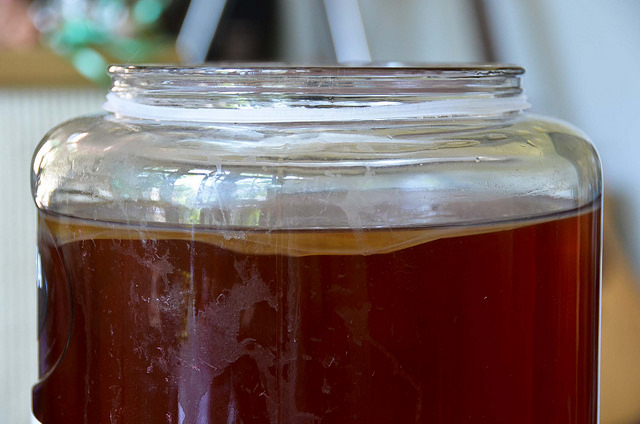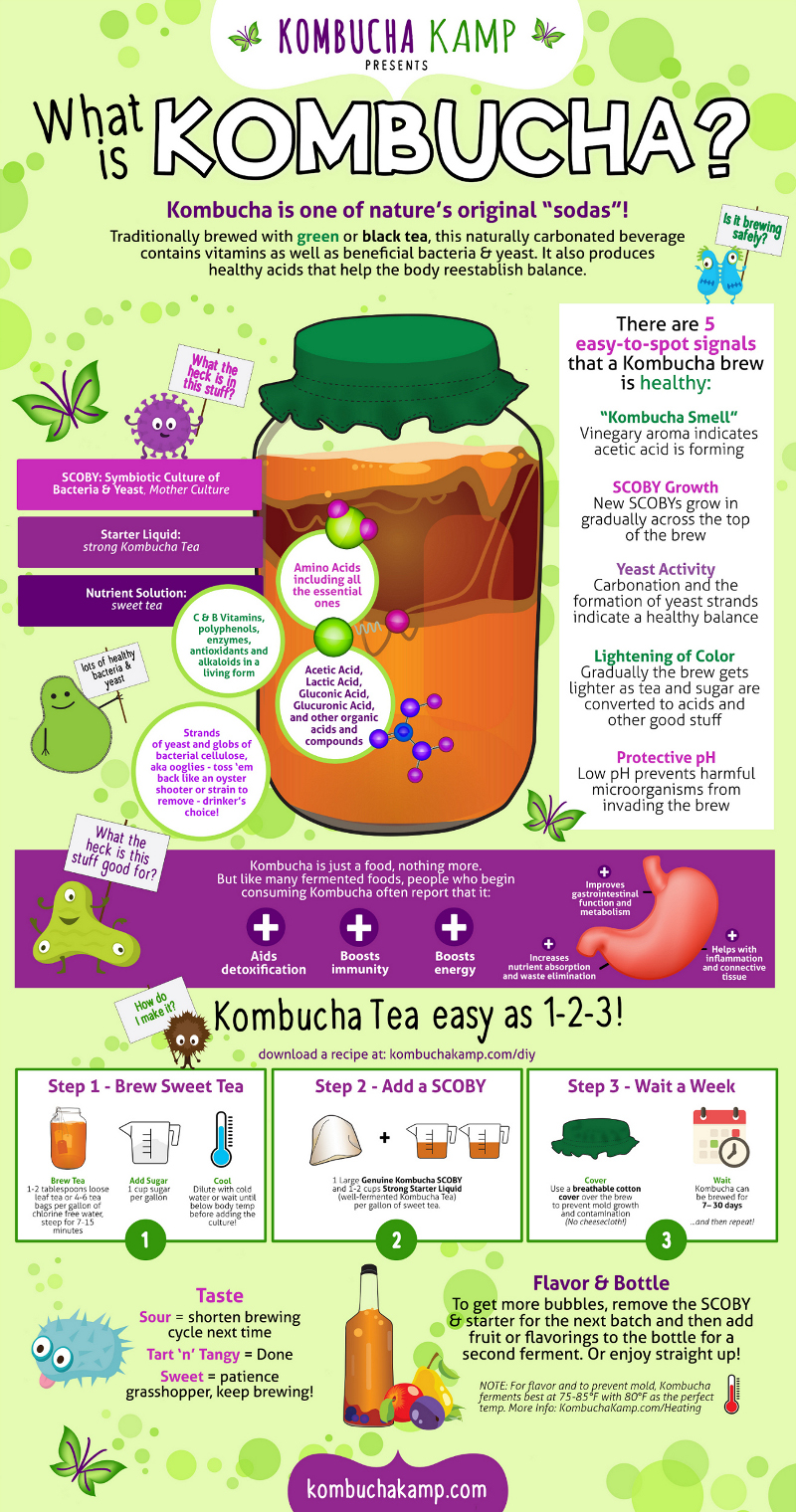
Perhaps you’ve found yourself in front of an endcap display of Kombucha, mesmerized by the colorful liquid with its attractive packaging and array of enticing flavors, wondering “but what is it?”
Maybe you’re a regular drinker of the stuff and want to learn more about this centuries-old elixir and even brew it at home. No matter your level of familiarity with it, we have the information needed to get a better understanding of Kombucha and how it’s made.
What is Kombucha?
In two words, Kombucha is nature’s soda. It’s a naturally fizzy fermented beverage that is loaded with probiotics and nutrients.
Kombucha starts out as a sweet tea solution—tea, water, and sugar. Things get interesting when the SCOBY, or symbiotic culture of bacteria and yeast, along with a bit of mature Kombucha tea are added. The SCOBY consists of bacteria and yeast bound together with cellulose fibers, creating a mass that is also called a “zoogleal mat.” The SCOBY is what creates the fermentation process as the healthy bacteria and yeast feed on the sugar and tea, offering probiotics, nutrients, carbonation, and that classic tart and tangy flavor in the process.
Why Drink Kombucha?
Is the term “zoogleal mat” not perking up your appetite? Creeped out by the idea of bacteria and yeast in your beverage? Stay with us.
Kombucha is a fermented food, and it’s one among many options. Other fermented foods include:
Pickles
Yogurt
Wine and beer
Sauerkraut
Kimchi
Most cheeses
Soy sauce and tamari
Tempeh
Miso
Fermented foods by their nature contain yeast and bacteria as they are the organisms that break down and preserve the substrate—that is, cabbage turns into sauerkraut, grape juice into wine and in this particular case, tea and sugar into kombucha. Bacteria cover every surface on the planet, including inside and on the human body. Many of them are actually good for us and absolutely essential to our health. As the human body is comprised of approximately 10 trillion human cells, with 90 trillion being bacterial cells, it’s clear that bacteria are pretty important to the healthy functioning of our bodies.
The healthy bacteria and yeast in Kombucha and other ferments are known as probiotics, which help keep our digestive system in balance. An out-of-whack digestive tract isn’t able to absorb and use the wonderful micronutrients in the foods we eat. And that’s a shame, because the nutrients in our food are what keep us healthy and happy.
Kombucha is not a cure for anything, but like all fermented foods, it can help the body bring back into balance. This is especially apparent when paired with a wholesome diet, but fermented foods can benefit any diet. Besides improved gut health, many people report that kombucha:
Helps detoxify the body
Boosts the immune system
Increases energy
Reduces inflammation
The fermentation process also creates other things the body can benefit from:
All essential amino acids
C and B vitamins, polyphenols, enzymes, antioxidants, alkaloids
Acetic acid, lactic acid, gluconic acid, glucuronic acid, and others
How to Brew Kombucha
Many people like to buy their Kombucha at the grocery store, and that’s just fine. However, DIY Kombucha is a cost-effective way to keep a supply around. Brewing Kombucha is also a fun science experiment. Plus, it can be flavored just like the ones at the store.
The steps below are for brewing up a one gallon batch.
Ingredients:
1 gallon of water
1-2 tbsp. loose leaf tea or 4-5 tea bags
1 cup sugar
1 large genuine SCOBY
1-2 cups starter liquid (mature Kombucha tea)
Supplies:
Gallon container (try a glass jar)
Breathable, tightly woven cotton cover & rubber band (no cheesecloth)
Thermometer strip (ideal temperature is between 75-85°F, with the 80°F as the sweet spot)
1. Make sweet tea
>> Brew one gallon of tea
>> Dissolve sugar in the tea
>> Allow to cool to body temperature
2. Add SCOBY and starter liquid
>> Carefully add the SCOBY and starter liquid to the sweet tea
3. Cover and wait
>> Cover container
>> Place container in a dark, dry place where the temperature is 75-85°F
>> Wait one week, and begin taste testing the brew each day until it’s ready. The finished product should be tart and tangy—not too sweet or sour.
When it’s ready, carefully put the SCOBY with some mature tea in another container. Enjoy as is or flavor it.
Other signs of a healthy brew:
Vinegar-like aroma
New SCOBY growth
Yeast activity–carbonation and yeast strands floating in the liquid
Lighter color of tea
Low pH levels
Kombucha might seem like a health food trend, but it’s an ancient tradition that isn’t going anywhere. Learning more about Kombucha and other fermented foods is a great start to a healthier lifestyle and a happier gut. Cheers!
Authors: Hannah Crum & Alex LaGory
Editor: Catherine Monkman
Images: Iris/Flickr, Infographic courtesy of KombuchaKamp









Read 0 comments and reply